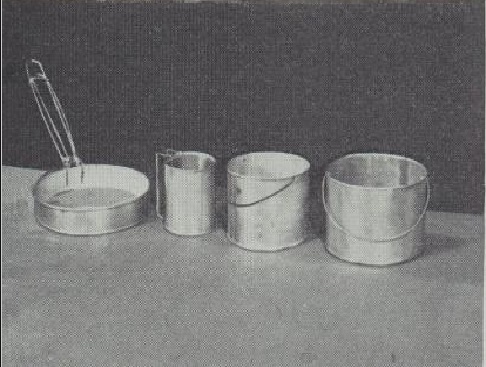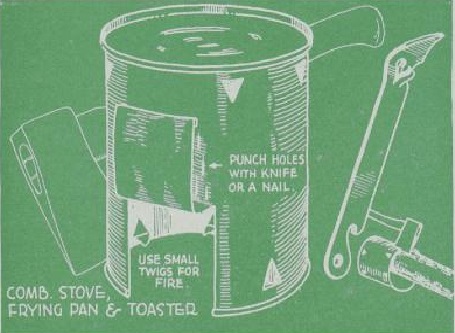 x
x
Today, if you buy a mess kit like the one shown at left, you can inexpensively take care of your cooking and serving needs for a camping trip of a few days. But if you want to economize even further, you can take advantage of the plans found 75 years ago this month in Boys’ Life magazine, April 1948.
A Scout is Thrifty, and the magazine showed those thrifty scouts how to make a similar mess kit out of old tin cans. With a few simple hand tools, the cans can be cut to size. The article showed a technique for smoothing the cut edge with a hammer. Handles are made with stiff wire. The author used a fly swatter handle, but a metal coat hanger would work just as well.
The article notes that almost any kind of can may be used, although it warned to never use a paint can. It warned that since cans back then were neither aluminum nor stainless steel, it was important to dry the items thoroughly after washing. However, modern cans are probably more forgiving.
 Advanced scouts could construct from a one-gallon can the combination stove/toaster/frying pan shown at left. It’s pretty self-explanatory–the fire goes inside the inverted can. The door for putting in the wood fuel serves double duty, as it folds upward to provide a spot to snap a slice of bread in place for toasting.
Advanced scouts could construct from a one-gallon can the combination stove/toaster/frying pan shown at left. It’s pretty self-explanatory–the fire goes inside the inverted can. The door for putting in the wood fuel serves double duty, as it folds upward to provide a spot to snap a slice of bread in place for toasting.

This issue of the magazine is also useful to scout historians, because it includes a removeable booklet section showing the Tenderfoot-Second Class-First Class requirements which had just been adopted. Many of our readers, of course, will be interested to know what the signaling requirement was back then. I recall that about the time I joined in the 1970s, the First Class requirement was that the Scout be able to use Morse Code or semaphore. I’ve been told, although I haven’t confirmed it, that at one point, Scouts had to know both Morse Code and semaphore. But in 1948, the requirement was for Morse code only, although it could be done with flags, light, or sound:
Some links on this site are affiliate links, meaning that this site earns a small commission if you make a purchase after following the link.


